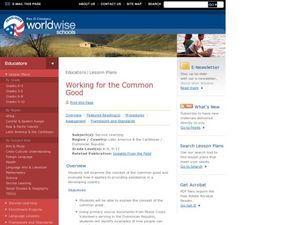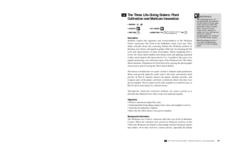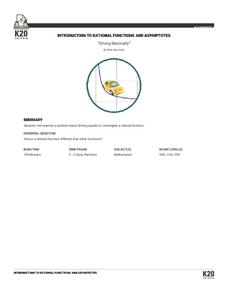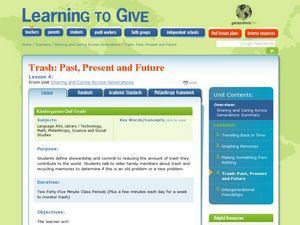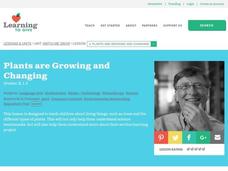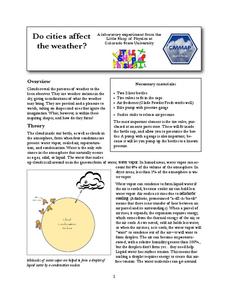Curated OER
Working for the Common Good
Students discuss the concept of the common good. Using primary source documents, they read accounts from volunteers in the Dominican Republic and discuss how they work for the common good. They reflect on the topic in their journals to...
Berkshire Museum
The Three Life-Giving Sisters: Plant Cultivation and Mohican Innovation
Children gain first-hand experience with Native American agriculture while investigating the life cycle of plants with this engaging experiment. Focusing on what the natives called the Three Sisters - corn, beans, and squash - young...
Curated OER
What is a Philanthropist?
What does a philanthropist do? Help your class explore philanthropy using character development and literacy ideas. Learners will define and give examples of philanthropy, listen to The Lion and the Mouse, discuss how the characters help...
Curated OER
Seeing the Image in Imagery: A Lesson Plan Using Film
In our increasingly visual society, it is often difficult for some readers to create a mental picture of a picture created only with words. An image-rich text like F. Scott Fitzgerald's The Great Gatsby can therefore, present a real...
PwC Financial Literacy
Charitable Giving
Charitable organizations and monetary donations to these organizations are the focus of the financial literacy lesson plan presented here. Learners explore how donations benefit both the organization and the people it serves. Each pupil...
Curated OER
Lesson Learned: Creating a Life Reports Project
Tap into the wisdom and knowledge of older members of the community with this New York Times plan. To warm up, learners write about and discuss advice they have been given. After reading "The Life Report," an op-ed column that asks older...
Curated OER
Put Your Hands in Mine: King Day
Students examine the concepts of human and civil rights. In this philanthropy lesson, students watch The Mighty Times: The Children March. Students discuss concepts relating to civil rights and change.
EngageNY
Bacteria and Exponential Growth
It's scary how fast bacteria can grow — exponentially. Class members solve exponential equations, including those modeling bacteria and population growth. Lesson emphasizes numerical approaches rather than graphical or algebraic.
EngageNY
Negative Exponents and the Laws of Exponents
Apply the properties of exponents to expressions with negative exponents. The fifth activity in the series explains the meaning of negative exponents through an exploration of the properties taught in the previous lessons of the series....
K20 LEARN
Driving Rationally: Introduction To Rational Functions And Asymptotes
Calculating average speeds is not as simple as finding an average. The lesson introduces class members to rational functions by presenting a problem about finding an average speed for the rest of a trip. Pupils develop an equation to...
Curated OER
It's Mine Lesson Plan
Students read a book called It's Mine! In this lesson about three frogs and sharing, students explore how what they do affects everything around them. Through a series of seven different activities, students interpret the frogs and their...
EngageNY
Numbers in Exponential Form Raised to a Power
Develop an understanding of the properties of exponents through this series of activities. This third lesson of 15 explores the patterns associated with the power property. Scholars expand the powers before applying the property.
Curated OER
An Apple a Day
Students explore the Johnny Appleseed story. In this service learning lesson, students sequence the life cycle of apple trees and recognize how Johnny Appleseed worked as a philanthropist.
Curated OER
Pollution Solutions: Earth Day
Eighth graders explore water pollution. In this stewardship lesson, 8th graders draw comparisons between potable and impaired waters. Students use the Learning Link website to examine ways people are fighting pollution and then design an...
Curated OER
Who Works for the Common Good in Our Community?
Students examine the role of community service organizations. As a class, they listen as members from local organizations speak to them and answer any questions they have. They respond in their journals to different prompts to end the...
Curated OER
Giving Generously
Students are read a book about giving. They discover that giving to others is rewarding. They also locate China on a map and make their own rice cakes.
Curated OER
What a Gift!
What is considered a valuable gift? As the class will come to find out, what is considered a gift varies by time and location. After viewing images of a Mayan pot that depicts men giving cacao to the gods, learners research three...
Curated OER
Center Stage—Focus on Poverty
Middle schoolers explore the concept of philanthropy. In this service learning lesson plan, students examine stereotypes and discrimination based on socio-economic status. Middle schoolers prepare to work with people of diverse...
Curated OER
Trash: Past, Present and Future
Students explore how much trash they create. In this recycling lesson, students define stewardship and conduct an experiment to see how much trash the class produces in a week. At the end of the week the students propose ways to...
Curated OER
Plants are Growing and Changing
Students explore living things. In this agriculture lesson, students read the book A Tree is a Plant and participate in an experiment to explore the patterns of change in living things. Students continue to observe the plant throughout...
Curated OER
What Is a Watershed?
Students explore the concept of water pollution. In this environmental stewardship lesson, students discover what watersheds are and consider how to protect them.
Curated OER
Feeling Good About My Body: A Lesson on Self Esteem
Third graders explore the concept of self esteem. In this health lesson, 3rd graders participate in several classroom activities that address developing a positive self concept.
Curated OER
Does The Type of Mulch Used Affect Plant Growth?
Students measure, record and graph the plants they grow in a controlled setting. They feed and water the plants as needed and use the scientific method to evaluate the growth.
Colorado State University
Do Cities Affect the Weather? (Making a Cloud in a Bottle)
The dynamics of a city can have a drastic effect on the weather. A hands-on lesson asks learners to build a model to illustrate how city pollution provides a nucleus for condensation. The greater the pollution, the greater chance for...


